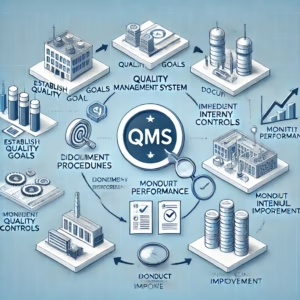A Quality Management System (QMS)
There is a structured framework that helps businesses to ensure consistent product and service quality. Whether you are in the food safety, manufacturing, or services industry, implementing a QMS improves compliance, efficiency, and customer satisfaction. In this guide, we will cover the purpose, implementation, and effectiveness measurement of QMS.
What is a Quality Management System (QMS)?
There is a complete set of processes, policies, and documentation that helps an organization maintain high-quality standards. It helps ensure compliance with industry regulations such as ISO 9001, HACCP, and GMP.
What is the Purpose of a Quality Management System?
- Enhances product consistency and reliability
- Ensures regulatory compliance (ISO 9001, FDA, HACCP, etc.)
- Reduces errors and operational costs
- Improves customer satisfaction
- Helps in achieving business goals efficiently
Why Have a Quality Management System?
Businesses can achieve efficiency, cost reduction, and reducing risk while following high standards of quality with the support of a properly executed QMS.
How to Implement a Quality Management System?
Step-by-Step Guide to QMS Implementation
- Define Quality Objectives: Set clear quality goals based on business needs.
- Develop a QMS Framework: Identify key processes and create proper documentation for them.
- Assign Responsibilities: Clear roles ensure for quality assurance and compliance.
- Train Employees: Provide QMS training to staff for effective execution.
- Implement and Monitor : Conduct audits and use KPIs to track performance.
- Continuous Improvement: Adapt and refine the QMS based on data insights.
How to Create a Quality Management System?
- Identify key quality standards (ISO 9001, HACCP, GMP)
- Establish policies and procedures
- Utilize digital tools like EQMS (Electronic QMS) for automation
- Conduct regular risk assessments and compliance checks
Measuring the Effectiveness of a Quality Management System
How to Measure the Effectiveness of QMS?
- Key Performance Indicators (KPIs): Defect rate, audit scores, customer complaints
- Internal Audits: Periodic assessments to ensure compliance
- Customer Feedback & Satisfaction Surveys
- Process Performance Metrics: Time-to-market, production efficiency, cost reduction
The Role of QMS in Business Growth
How Does a Quality Management System Improve Business?
- Boosts operational efficiency
- Enhances customer trust and loyalty
- Reduces rework and waste
- Strengthens brand reputation
Common QMS Challenges and Solutions
- Implementation Hurdles: Solution → Proper training & leadership support
- Regulatory Compliance Issues: Solution → Regular internal audits
- Employee Resistance: Solution → Strong communication & involvement
- Data Management Challenges: Solution → Implement digital QMS solutions
FAQs About Quality Management Systems
1. What is the main purpose of a QMS in a project?
To ensure quality control, regulatory compliance, and efficient project execution.
2. What is ISO 9001 Quality Management System?
ISO 9001 is a globally recognized QMS standard ensuring consistent quality and continuous improvement.
3. Why is QMS important for food businesses?
QMS ensures food safety, regulatory compliance, and product consistency in HACCP-certified businesses.
4. How to implement a Quality Management System?
Follow structured steps: define objectives, document processes, train employees, and monitor continuously.
5. How does a Quality Management System benefit small businesses?
It helps improve efficiency, ensures compliance, reduces waste, and enhances customer trust.
6. What are the key components of a QMS?
Policies, procedures, work instructions, quality objectives, and continuous improvement mechanisms.
7. What industries require a Quality Management System?
Manufacturing, food processing, healthcare, IT, construction, and pharmaceutical industries.
8. What is the role of leadership in QMS?
Leadership ensures commitment, resource allocation, and continuous improvement of QMS.
9. How to measure the ROI of a QMS implementation?
By evaluating cost savings, error reduction, compliance improvements, and operational efficiency.
10. What are the common challenges in maintaining a QMS?
Lack of proper documentation, employee resistance, outdated technology, and inconsistent audits.
Download Free QMS PDF Guide
Download our “Quality Management System PDF” to get a step-by-step QMS implementation checklist. QMS_Guide (1)
Conclusion
Implementing a Quality Management System (QMS) is essential for maintaining consistent quality, regulatory compliance, and customer satisfaction. By following industry standards such as ISO 9001, HACCP, and GMP, businesses can improve efficiency and minimize risks. ISO Standards on Key Processes
Related Articles on Our Website (Internal Linking)
- QC vs QA: Key Differences – Understand the difference between Quality Control (QC) and Quality Assurance (QA) in food safety.
- FSSAI Food Safety Guidelines – A complete guide on FSSAI regulations and compliance for food businesses.
- What is HACCP? – Learn about the 7 principles of HACCP and how they help in food safety management.


Pingback: Perishable Food: Storage, Safety, and Best Practices - foodtechzone